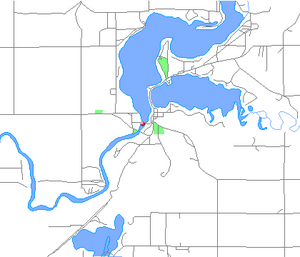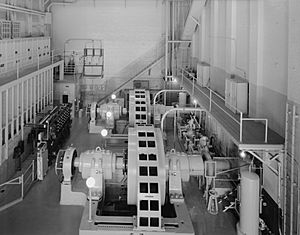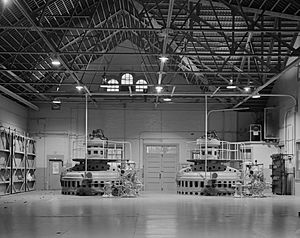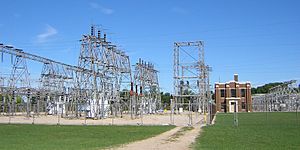Croton Dam (Michigan) facts for kids
Quick facts for kids Croton Dam |
|
|---|---|

Croton Dam and Hydroelectric Plant
|
|
| Official name | Croton Hydroelectric Plant |
| Country | United States |
| Location | Croton Township, Newaygo County, Michigan |
| Coordinates | 43°26′14″N 85°39′50″W / 43.43722°N 85.66389°W |
| Purpose | Power |
| Status | Operational |
| Construction began | 25 June 1907 |
| Opening date | 3 September 1907 |
| Owner(s) | Consumers Energy |
| Dam and spillways | |
| Type of dam | Embankment, earth-fill |
| Impounds | Muskegon River |
| Height | 40 ft (12 m) |
| Length | 370 ft (113 m) |
| Width (crest) | 20 ft (6 m) |
| Width (base) | 800 ft (244 m) |
| Dam volume | 104,000 cu yd (79,514 m3) |
| Reservoir | |
| Creates | Croton Reservoir |
| Total capacity | 22,095-acre-foot (27,253,781 m3) |
| Surface area | 1,209-acre (489 ha) |
| Power station | |
| Commission date | 1907/1915 |
| Type | Run-of-the-river |
| Turbines | 2 x 4.4 MW Francis-type |
| Installed capacity | 8.85 MW |
|
Croton Hydroelectric Plant
|
|
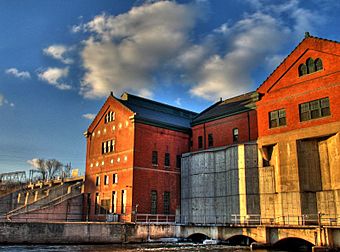
Croton Dam powerhouse from SE downstream side
|
|
| Lua error in Module:Location_map at line 420: attempt to index field 'wikibase' (a nil value). | |
| Architect | William D. Fargo |
| NRHP reference No. | 79001165 |
| Significant dates | |
| Added to NRHP | August 8, 1979 |
The Croton Dam is a special kind of dam called an earth-filled embankment dam. It's also a power plant that makes electricity. You can find it on the Muskegon River in Croton Township, Newaygo County, Michigan.
This dam was built in 1907 by the Grand Rapids - Muskegon Power Company. This company later became part of Consumers Energy, which still owns the dam today. The Croton Dam is about 40-foot-high (12 m). It holds back a huge amount of water, about 7.2 billion U.S. gallons (27 billion liters). This water forms a large lake called the Croton Reservoir, which covers 1,209-acre (489 ha). The dam can produce 8,850 kilowatts of electricity when it's working at its best. Because of its importance, the Croton Dam was added to the National Register of Historic Places in 1979.
Contents
How the Croton Dam Was Built
The story of the Croton Dam is linked to two brothers, William A. Foote and James B. Foote. They were from Adrian, Michigan. They worked with William G. Fargo, an engineer from Jackson. Fargo designed many similar power plants in the Midwest.
Early Electric Power
In 1884, William A. Foote ran a grist mill (a mill that grinds grain) in Adrian. He let a local electric company use power from his mill to light 12 streetlights. He was very interested in this new idea. A year later, he and his younger brother James moved to Jackson, Michigan. In 1886, they started the Jackson Electric Light Works. This company was an early version of Consumers Energy. They began by lighting up downtown Jackson.
The Foote brothers also started similar companies in other cities like Battle Creek and Adrian. Sometimes, they would update old dams that were used for mills to make electricity. Other times, they built new dams. As they learned more and technology improved, their projects became bigger and more exciting.
Building Bigger Dams
At first, electric power was mainly used for streetlights and a few homes or businesses. The power plants had to be close to the cities they served because sending electricity over long distances was hard. But people wanted more power for things like streetcars and factories. Smaller rivers and old dams couldn't make enough electricity. So, the Foote brothers looked for bigger rivers.
In 1898, they worked with engineer Fargo to build the Trowbridge Dam on the Kalamazoo River. This dam supplied power to Kalamazoo. It was about 25 miles (40 km) away, which was a very long distance for sending electricity back then! At first, they had problems with power loss. But the Foote brothers improved insulators and transmission equipment. This helped the Trowbridge Dam successfully provide power to a much larger area.
Damming the Muskegon River
Next, the Foote brothers wanted to bring power to Grand Rapids, a much larger city. Fargo suggested places on the Muskegon River. The Muskegon River is Michigan's second largest inland river. Unlike the Grand River, the Muskegon isn't used for boats, so building dams wouldn't stop river traffic.
In 1904, their company, the Grand Rapids – Muskegon Power Company, started building Rogers Dam and Croton Dam on the Muskegon River. Rogers Dam was finished first in 1906. But the Croton Dam was a much bigger project. It was built where the Little Muskegon River joins the main Muskegon. When the lake behind the dam started filling in August 1907, about one-third of the village of Croton was covered by water. William D. Fargo was the main engineer in charge of building the dam.
Building the Dam with Water Power
Fargo came up with new ways to build earth dams on soft ground. He used a method called "hydraulic sluicing." This means using high-pressure water to move earth. The dam was built very quickly, between June 25 and September 3, 1907. The power plant and spillway (where excess water flows out) were built first using normal methods.
Then, Fargo set up a pumping plant. It used seven electric pumps to send river water up a 10-inch (250 mm) pipe to a bluff about 110 feet (34 m) above the river. The pipe got narrower to 4 inches (100 mm), which made the water shoot out at high pressure (about 80 PSI). This powerful stream of water washed away soil and water into metal troughs. These troughs carried the mix about 800 feet (240 m) back to the dam site. As the material settled, the water drained away, making the earth very compact. While this was happening, the river flowed through the power plant and out the spillway.
The Croton Dam was one of the first places east of the Mississippi River to use this clever method. The best part was how cheap it was! Building the 370-foot-long (110 m) earth dam, which used 104,000 cubic yards (80,000 m3) of material, only cost $7,076. That's about 7 cents for every cubic yard of earth moved! Fargo also used this method to build a fill for a highway bridge near the dam.
The Croton power plant has two connected buildings: one for generators and one for turbines. They are shaped like an "L." About 3,000 oak timber pilings (long wooden poles) support the concrete foundation. The buildings are about 60 feet (18 m) tall and measure about 150 by 80 feet (46 by 24 m).
When the generator building first opened, it had two Westinghouse generators. These generators made electricity at 6,600 volts. This voltage was then increased to 100,000 volts using large transformers. These transformers and other equipment were in the south end of the generator building.
The Croton Dam and power plant were finished in 1907. A big opening celebration was held on September 7, 1907. Important people from Grand Rapids came on a special train. They toured the dam and power plant, had a nice dinner, and even played a baseball game!
To send power efficiently over 50 miles (80 km) to Grand Rapids, a 100,000-volt high voltage line was built. This was the highest-voltage transmission line in the world at that time! A famous engineer named Dr. Charles Proteus Steinmetz visited the site in 1908 to test the lines. The line voltage was increased to 110,000 volts in early 1909.
Dam Upgrades and Changes
In 1915, the dam's power-making ability was greatly improved. More turbines and generators were added. The generator building got pairs of Allis-Chalmers turbines to run the Westinghouse generators. Each pair of turbines could make 4,000 horsepower. The voltage of the original generators was raised to 7,500 volts, and the line voltage went up to 115,000 volts.
The turbine building was also changed to hold more equipment. It was made larger and given a similar roof design to the generator building. It has a much higher floor and received a pair of vertical turbine/generator sets.
In 1930, the transformers and switching equipment were moved out of the generator building. A separate switchyard (a place with electrical switches and equipment) was built to the west of the spillway. Soon after, in 1931, the Croton and Rogers dams were joined by the Hardy Dam. The Hardy Dam was built between them and was the last big hydroelectric project by Consumers Energy in Michigan.
A Lasting Legacy
After the Croton Dam was finished, a historical marker sign was placed there. It told visitors about the dam's importance. It mentioned that the plant and its 110,000-volt transmission line were famous worldwide. Engineers from many countries came to see it. The sign said the plant showed the newest ideas in making and sending electric power.
The Croton Hydroelectric Plant is listed on the Michigan State Register and has a Michigan Historical Marker. It was also added to the National Register of Historic Places in 1979.
Croton Dam Today
Today, the Croton Dam and its power plant are still owned and run by Consumers Energy. In 2006, the Croton Dam made 44 million kilowatt hours of electricity. This is enough power for about 6,000 homes for a whole year!
Consumers Energy owns and operates three dams on the Muskegon River: Rogers, Hardy, and Croton. They all work together to manage the river's water flow.
- The Rogers Dam lets almost all the water flow through as it receives it.
- The Hardy Dam, which is upstream from Croton and has a larger reservoir, works in "full peaking" mode. This means it holds back water and releases it to make electricity when people need it most (during peak demand). This can cause the river's water levels to change a lot.
- However, the Croton Dam is right downstream from the Hardy Dam, with no river section in between. So, the Croton Dam can be run in "re-regulation" mode. This means it helps smooth out the water flow, making sure a more natural amount of water leaves the dam. The Croton reservoir's water level changes in the opposite way to the Hardy's. It rises during the day and lowers at night.
The Hardy Dam's reservoir level only changes about 4 inches (10 cm), but the Croton reservoir changes about 9 inches (23 cm). In winter and spring, when there's a lot of runoff, the Hardy Dam can let its water level drop more (up to 12 feet (4 m)) to meet winter power needs. But it must return to normal levels by the end of April.
Together, these three dams (Rogers, Hardy, and Croton) can produce about 45,500 kilowatts of electricity. The Hardy Dam makes about 30,000 kilowatts of that total.
Images for kids


